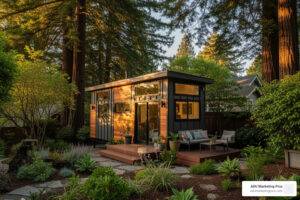California ADU guidelines have become a pivotal tool in addressing the state’s rampant housing shortage. In recent years, California has revamped its ADU laws, making it easier and more practical for homeowners and real estate professionals to build accessory dwelling units, commonly known as ADUs or “granny flats.” Here’s a quick overview:
- Relaxed Restrictions: ADUs can now be taller, accommodating more flexible designs and denser housing options.
- Streamlined Permitting: The process for obtaining an ADU permit is simpler and must be completed within 60 days, with thorough explanations provided if denied.
- Advocacy for Green Building: Encourages the use of eco-friendly materials and energy-efficient designs.
ADUs have surged in popularity not only due to these relaxed laws but also because they offer versatile living solutions, whether for additional family space, short-term rentals, or as a means to generate passive income. By facilitating the development of ADUs, California is working to tackle its housing crisis while giving homeowners the opportunity to maximize the utility and value of their properties.
As we dig deeper into this guide, we’ll explore these evolving regulations and how they translate into opportunities for ADU innovators like yourself.

Understanding California ADU Guidelines
Navigating California ADU guidelines can seem daunting, but understanding the basics will set you on the right path. Let’s break down the essentials, focusing on zoning rules, unit size, and setback requirements.
Zoning and Lot Requirements
In California, ADUs are allowed in most residential zones, including single-family and multifamily areas. However, local ordinances can vary, so it’s crucial to check the specific zoning laws in your area. For instance, Sacramento permits ADUs in most residential zones, but you must comply with local guidelines.
- Residential Zones: ADUs are generally permitted in areas zoned for residential use, but always verify local ordinances.
- Lot Size: While there are no statewide minimum lot size requirements, local jurisdictions might impose their own. Make sure your property meets these criteria before proceeding.
Unit Size and Design Specifications
When it comes to the size and design of your ADU, California has set clear guidelines to ensure both functionality and compliance.
- Maximum Size: Detached ADUs can be up to 1,200 square feet, whereas attached units have a cap of 850 square feet for a studio or one-bedroom, and 1,000 square feet for two or more bedrooms. However, an ADU cannot exceed 50% of the size of the primary residence.
- Detached vs. Attached: Decide whether a detached or attached ADU suits your needs. Detached units offer more privacy, while attached units can be more cost-effective.
Setback and Height Restrictions
Setbacks and height restrictions are crucial for maintaining safety and accessibility. Here’s what you need to know:
- Setback Requirements: A minimum setback of 4 feet from the side and rear property lines is required. This ensures safe distances between structures and helps with fire safety.
- Height Limits: In certain zones like R-1, the maximum height for an ADU is 35 feet. However, recent legislative changes now allow some ADUs to be built up to 18 feet tall, offering more design flexibility.
- Safety Standards: Compliance with safety standards is non-negotiable. Ensure your ADU design includes proper fire safety measures and adheres to local building codes.
By understanding these California ADU guidelines, you can better plan your ADU project, ensuring it meets both your needs and legal requirements. As you move forward, keep these guidelines in mind to avoid potential setbacks and maximize the potential of your property.

Next, we’ll dive into recent legislative changes impacting ADUs, including new laws like AB 2533 and SB 1211, which are reshaping the ADU landscape in California.
Recent Legislative Changes Impacting ADUs
California’s housing landscape is constantly evolving, and recent legislative changes are making it easier to develop and manage ADUs. Let’s explore three significant laws: AB 2533, SB 1211, and AB 1033. These laws address unpermitted ADUs, expand multi-family development, and introduce new opportunities for selling ADUs separately.
AB 2533: Path to Compliance for Older Units
AB 2533 offers a lifeline for those with unpermitted ADUs built before January 1, 2020. Previously, homeowners faced problems if their units didn’t meet current building standards. Now, local agencies cannot deny permits based on minor building standard violations, provided the structure is not substandard. This law creates a clear path for bringing existing units into compliance while ensuring they meet health and safety codes.
The focus here is on safety rather than penalizing homeowners for outdated standards. This change not only benefits property owners but also contributes to California’s housing stock by legitimizing more units.
SB 1211: Expanded Multi-Family Development
SB 1211 is a game-changer for multi-family properties. It allows property owners to build up to eight detached ADUs on lots with existing multi-family dwellings. The only condition is that the number of new units cannot exceed the total number of existing units.
This law also redefines “livable space” and removes the requirement to replace uncovered, off-street parking spaces demolished during ADU construction. This means more flexibility for property owners to maximize their space and increase housing availability.
AB 1033: Selling ADUs Separately
AB 1033 opens the door for selling ADUs as separate entities under specific conditions. This law primarily applies to affordable housing projects and certain pilot programs. The process often involves condominium conversion, allowing the ADU to become a separate real estate asset.
This shift in property rights can be a boon for homeowners looking to open up the value of their ADU. It offers a new avenue for generating income and potentially increases the overall property value. However, local ordinances still play a crucial role, and it’s important to consult with a real estate expert familiar with these regulations.
These legislative changes are reshaping the ADU landscape in California, providing more opportunities and flexibility for property owners. Understanding these laws can help you make informed decisions about developing and managing your ADUs.
Next, we’ll explore the California ADU guidelines for 2025, focusing on streamlined processes and owner rights.
California ADU Guidelines for 2025
California’s approach to accessory dwelling units (ADUs) is evolving, with new guidelines set for 2025. These guidelines focus on streamlined processes, owner rights, and financial considerations. Let’s dig into the specifics.
Streamlined Approval Processes
The 2025 guidelines emphasize efficiency in getting your ADU approved. One key feature is the 60-day rule, which mandates that local agencies must approve or deny ADU applications within 60 days. This accelerated timeline helps reduce delays and uncertainty for homeowners.
Additionally, the introduction of pre-approved plans simplifies the design process. These plans meet all state and local building codes, saving time and money. Homeowners can choose from a variety of designs that are ready for quick approval, making the path to building an ADU much smoother.
The ministerial review process further streamlines approvals. This means that if your ADU plans meet the pre-set criteria, they can be approved without a public hearing. This approach reduces bureaucratic problems and speeds up the entire process.
Owner Rights and Financial Considerations
The 2025 guidelines also strengthen owner rights, particularly concerning owner-occupancy requirements. Recent changes have permanently eliminated these requirements, allowing more flexibility for homeowners. This means you can rent out your ADU without having to live on the property, opening up new income opportunities.
Impact fees are another important consideration. ADUs under 750 square feet are exempt from these fees, while larger units face proportional charges. This policy reduces financial barriers for smaller ADUs, encouraging more homeowners to build.
Homeowners’ associations (HOAs) often influence local housing decisions, but the new guidelines curb their power over ADUs. The law now voids any HOA policies that restrict ADU development, ensuring that homeowners have the final say in using their property.

These updates reflect California’s commitment to increasing housing accessibility and affordability. By understanding the California ADU guidelines for 2025, homeowners can better steer the complexities of ADU development and take advantage of the new opportunities available.
Next, we’ll discuss the practical aspects of building and renting ADUs in California, focusing on rental income potential and regulations.
Building and Renting ADUs in California
Building an ADU as a Rental Property
Building an Accessory Dwelling Unit (ADU) can be a lucrative investment, especially when used as a rental property. Rental income potential is one of the main attractions for homeowners considering an ADU. With California’s ongoing housing shortage, demand for rental spaces is high, making ADUs a valuable asset.
Before you start building, it’s crucial to understand zoning laws and tax implications. Each city in California has its own zoning regulations that dictate where ADUs can be built. For instance, some areas only allow ADUs in residential zones. Checking with local authorities ensures compliance and avoids future legal issues.
From a tax perspective, ADUs can affect your property taxes. Building an ADU often increases the property’s assessed value, which can lead to higher taxes. It’s wise to consult a tax professional to understand how these changes might impact your financial situation.
Renting Regulations and Market Appeal
When it comes to renting out your ADU, understanding renting regulations is key. In California, the minimum rental period for ADUs is generally 30 days. This rule discourages short-term vacation rentals and encourages long-term housing solutions, aligning with the state’s housing goals.
Most cities require a business license or permit to legally rent out an ADU. Additionally, you may need to pay a Transient Occupancy Tax (TOT), which ranges from 6% to 14% of the rental price. For example, Los Angeles imposes a 14% TOT on short-term rentals.
The market appeal of your ADU can significantly influence rental income. Features like sustainable design, proximity to public transit, and modern amenities can attract higher-paying tenants. Keeping an eye on market trends helps you stay competitive and maximize your rental income.
In summary, ADUs offer an excellent opportunity for rental income, provided you steer the zoning, tax, and renting regulations effectively. Next, we’ll explore some frequently asked questions about California ADU guidelines, offering further insights into building and renting ADUs.
Frequently Asked Questions about California ADU Guidelines
What are the rules for building an ADU in California?
When considering building an Accessory Dwelling Unit (ADU) in California, understand the California ADU guidelines. These include regulations on maximum size, local ordinances, and building codes.
-
Maximum Size: Detached ADUs can be up to 1,200 square feet, while attached ADUs are limited to 850 square feet for a studio or one-bedroom unit and 1,000 square feet for units with two or more bedrooms. However, no ADU should be more than 50% of the size of the main residence.
-
Local Ordinances: Each city may have its own specific rules, so check local zoning laws. For example, Sacramento requires a 4-foot setback from property lines and limits ADU height to 35 feet in certain zones.
-
Building Code: ADUs must comply with California’s building codes, including safety standards and energy efficiency requirements. This includes the installation of solar panels on newly built, detached ADUs.
Can I sell my ADU separately in California?
Under typical circumstances, ADUs are tied to the primary residence and cannot be sold separately. However, Assembly Bill 1033 (AB 1033) introduces some exceptions:
-
AB 1033: This law allows for the separate sale of ADUs in certain cases, such as when they are converted into individual condominiums. This is particularly applicable in larger cities like Sacramento.
-
Condominium Conversion: To sell an ADU separately, homeowners may need to go through a condo conversion process, which involves getting city approval to legally split the main home and the ADU into separate units.
-
Local Ordinances: It’s crucial to verify with local authorities whether your city participates in AB 1033 programs and to understand any additional requirements for condominium conversion.
Are there any restrictions on renting out an ADU in California?
Renting out an ADU can be a great way to generate income, but there are restrictions to keep in mind:
-
Rental Income: ADUs can be rented out to generate rental income, but the rental agreement must comply with local laws and regulations.
-
Location: Some cities have specific rules about where ADUs can be rented, often tied to zoning laws. For instance, properties near public transportation may have relaxed parking requirements for ADUs.
-
Rental Agreement Terms: California law mandates a minimum rental period of 30 days for ADUs. This rule encourages long-term rentals and discourages short-term vacation rentals. Additionally, many cities require a business license or permit to rent out an ADU legally.
Understanding these guidelines ensures that you can build and rent your ADU in compliance with state and local regulations. Next, we’ll dive into more detailed aspects of recent legislative changes impacting ADUs in California.
Conclusion
The demand for Accessory Dwelling Units (ADUs) in California is on the rise, driven by legislative changes and a pressing need for affordable housing solutions. As the ADU sector continues to grow, it becomes crucial for construction and architecture firms to steer this evolving landscape effectively.
ADU Marketing Pros is at the forefront of helping these firms succeed. Our digital marketing solutions are custom specifically for the ADU market, ensuring that your expertise stands out in a competitive field. We focus on attracting high-quality leads and growing your revenue by leveraging targeted SEO, PPC, and social media strategies.
Our approach is grounded in continuous market research and data-driven insights. This allows us to stay ahead of regulatory changes and consumer trends, providing you with the tools needed to thrive in the ADU sector.
By partnering with us, you gain a trusted ally committed to driving measurable growth. We understand the unique challenges faced by ADU businesses and are dedicated to helping you overcome them. Our goal is to establish your firm as the go-to authority in the ADU market, ensuring long-term success and a strong brand identity.
If you’re ready to take your ADU business to the next level, explore our marketing solutions and find how we can help you stand out and succeed.




